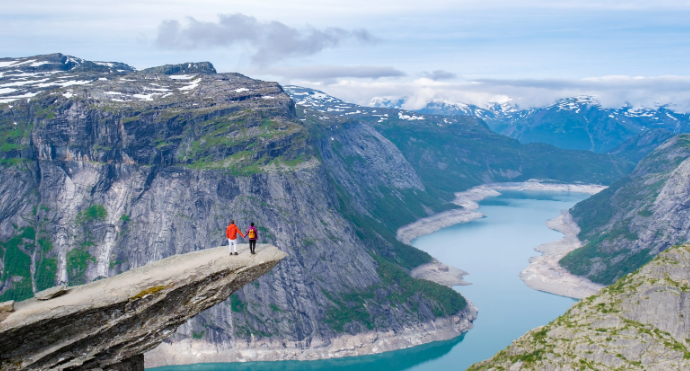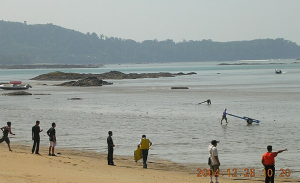
A 7.9-Meter Wave Sloshed in a Fjord—and the Whole World Felt It
On a quiet September day in 2023, the Earth gave off a strange hum. Scientists around the globe picked up a mysterious seismic signal—a deep, rhythmic pulse at 10.88 millihertz, as if the planet itself had a heartbeat. It lasted nine days. Then, a month later, it happened again. But where was it coming from? And what in the world could cause a vibration that shook the globe… twice?
Turns out, the answer may lie in an icy Arctic fjord that got rocked by a megatsunami—and responded by sloshing like a giant bowl of soup.
Welcome to the weird and wild world of seiches: Earth’s most dramatic, and least understood, water wobblers.
A Tsunami’s Hidden Aftershock
Let’s set the scene. Deep in East Greenland’s Dickson Fjord, a massive chunk of glacier and rock suddenly broke loose and thundered into the water. The result? A landslide-triggered megatsunami that surged through the fjord, leaving 60-meter-high wave marks in its wake. But this wasn’t just your average Arctic disaster.
After the tsunami passed, something strange lingered. A sloshing, back-and-forth motion continued inside the fjord—like a drink jiggling in a shaken glass. That motion, scientists now believe, created a seiche: a standing wave that just… wouldn’t stop.
And this wasn’t just local turbulence. That seiche sent tremors across the globe, triggering an eerie seismic signature detected by instruments thousands of kilometers away. In fact, it’s the first time scientists have ever directly observed such a long-lasting, high-powered seiche without any ongoing external force.
Satellite Sleuthing from Space
How do you even begin to study a water ripple in the middle of an icy, remote fjord?
Enter NASA’s SWOT (Surface Water and Ocean Topography) satellite. This bad boy orbits Earth with ultra-high-resolution radar, capable of measuring sea surface heights down to the centimeter—even inside narrow fjords that most satellites can’t touch.
When SWOT passed over the Dickson Fjord just after the two tsunami events in September and October 2023, it captured rare snapshots of the fjord’s water surface. What it saw confirmed scientists’ suspicions: sloping water levels that matched the wiggle of a standing wave—a seiche—sloshing side to side, even days after the landslides.
Using clever seismic comparisons, Bayesian math, and satellite images, researchers calculated that this wave was nearly 8 meters tall. That’s like a two-story building, sloshing inside a valley the size of Manhattan.
And here’s the kicker: this watery oscillation had no motor running. After the tsunami, the fjord just kept rocking itself—for days. That’s never been seen before.
“Wait—Why Didn’t the Military Notice This?”
Great question. The Danish military was surveying the fjord three days after the first event… and saw nothing.
That’s the weird thing about seiches. Unlike big crashing waves, a seiche is sneaky. It can look like a gentle tilt in the water, even while it quietly packs enough force to shake the ground. Think of it like an invisible metronome, ticking out power you can’t see—but the planet can feel.
So What Does This Mean for the Rest of Us?
Besides sounding like the plot of an Arctic thriller, this research actually tells us a lot about how climate change is rewriting the rulebook for natural disasters.
Here’s why this discovery matters:
- It proves that glacial landslides can generate global seismic signals. That’s a big deal for earthquake monitoring and early warning systems.
- It shows that fjords—normally quiet, icy cul-de-sacs—can act like giant amplifiers.
- It validates new satellite tools like SWOT, which are critical for studying remote, climate-sensitive regions that scientists can’t easily reach.
As Arctic ice melts faster and unstable slopes become more common, events like this may go from rare to routine. Knowing how to track and understand them could make a real difference for safety, climate science, and even infrastructure planning around fjords and coastal zones.
What You Thought You Knew… But Here’s What the Science Says
You might assume earthquakes shake the Earth and tsunamis crash into coastlines—but did you know that a tsunami’s echo can hum through the planet for days?
Or that satellites now listen to the oceans, not with sound but with light-speed radar, measuring tiny surface shifts to reveal secrets hidden from human eyes?
Science is catching up to nature’s strange rhythms—and with tools like SWOT, we’re finally able to “hear” what the oceans have been whispering for years.
Let’s Explore Together
Seiches are just one piece of the puzzle as we try to understand our changing planet. So now it’s your turn:
- What would you do if your local lake suddenly started sloshing for days?
- Do you think satellites should be used more to track extreme events?
- What’s the weirdest science fact you’ve learned recently?
Drop your thoughts in the comments or share this story with someone who loves weird science. Because when the Earth hums… we should be listening.
Stay Updated or Risk Falling Behind
Science is evolving rapidly—and in today’s chaotic information landscape, falling behind means losing ground to misinformation. This Week in Science delivers the most essential discoveries, controversies, and breakthroughs directly to your inbox every week—for free.
Designed for educators and science-savvy citizens, it’s your shield against bad data and outdated thinking.
Act now—subscribe today and stay ahead of the curve.
🔗 Liked this blog? Share it! Your referrals help defend truth and spread scientific insight when it matters most.



